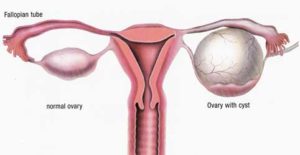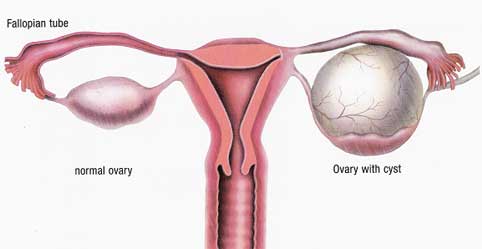An ovarian cyst is a growth that is composed mainly of fluid and contained within a very thin wall. Cysts of this type develop within an ovary and may not be immediately detectable. It is possible for these cysts to be no larger than a pebble, or grow to a size similar to a small watermelon. It is important to note that the presence of a cyst does not automatically mean that cancer is present in that respective ovary.

There are several Types of Cysts that may develop during the childbearing years:
Graafian follicle cysts
These are the most common type, and are most likely to develop when an egg does not release properly during ovulation. Generally, the cyst will gradually be reabsorbed into the system over the course of several menstrual cysts and cause no problems whatsoever.
Corpus Luteum cysts
These also develop during the menstrual cycle when an egg fails to release. With this type of cyst, the thin wall containing the fluid may rupture. This in turn releases fluid back into the ovary. Like the Graafian follicle cyst, the corpus luteum cyst will reabsorb into the system over the course of three or so periods.
Hemorrhagic cysts
These types of cyst are capable of inflicting a great deal of pain. Sometimes referred to as blood cysts, hemorrhagic cysts undergo small ruptures in one of the blood vessels in the cyst wall. This releases blood back into the ovary and can be extremely painful. While surgery is sometimes necessary, many women can take medication and rest for several days as the body heals.
Pathological and Endometrioid cysts
Both of these have the potential to create severe health issues for women. Should the development of a pathological cyst take place, it can lead to Polycystic Ovarian Syndrome, a condition that increases the chances of pregnancy loss, affects fertility, and can produce an unusual amount of bleeding during menstruation.
Symptoms will vary based on the type and size of the growth. A constant dull pain in the area of the pelvis, lower back, and extending to the vagina is not uncommon. The level of pain can progress from that dull ache to sharp pains that come and go without warning.
Changes in weight, a sense of nausea, and changes in urination and bowel movements are also common. Pain levels at the beginning and end of the menstrual cycle are likely, as well as feelings of being bloated and heavy. Various parts of the body, in particular the breasts, may become tender to the touch for no apparent reason.
A physician may approach the task of Treatment in several ways. Because the vast majority of these cysts are benign, the focus is often on providing relief from the symptoms. Over the counter pain relievers can often help, although some women may require prescription painkillers when the level of discomfort is particularly high.
Applying heat to the lower back, pelvis, and abdomen may also alleviate some of the pain. Some women find that using cold compresses or a bag of ice covered with a towel may also bring some relief. Surgery is only employed if there is suspicion of the presence of a Complex Ovarian Cystthat could or has already developed into a malignancy.
Many women have questions about cysts of this type. A qualified physician can answer questions such as:
– What is an Ovarian Cyst,
– What is the difference between Ovarian Cancer and Ovarian Cysts,
– The relationship between Ovarian Cysts and Pregnancy, and
– The chances for the development of an Ovarian Cyst After Menopause.
Taking the time to learn about this type of cyst, what to look for in the way of symptoms, and how the condition can be treated will help to take some of the mystery and thus the fear out of what is rarely a life threatening situation.
